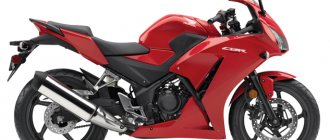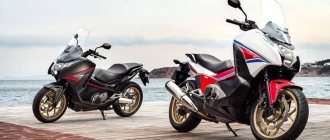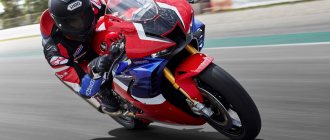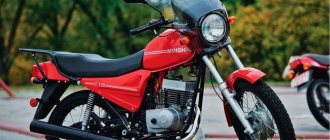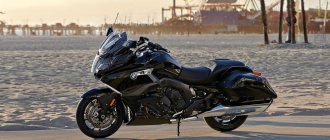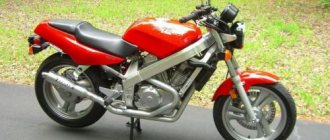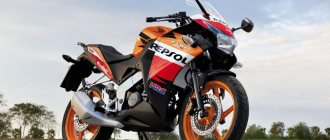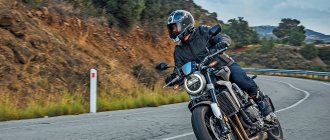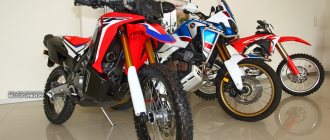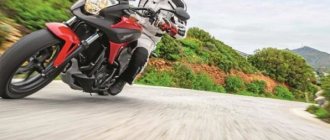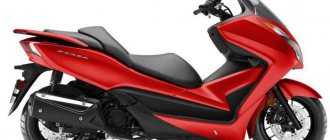Honda CB300R (2018+)
Honda CB300R naked model
was introduced in 2022 as a successor to the Honda CB300F and a junior version in the new line of Neo Sports Café road motorcycles, where the Honda CB1000R model acted as the flagship model. This line is distinguished by a general classic style with a round headlight, but in a modern interpretation - LED optics, inverted forks, LCD instrument panel, etc. Thus, by 2022, Honda replaced the CB-F series road motorcycles with the new CB-R, calling it Neo Sports Café.
Unlike the CB300F, the new CB300R model has a number of differences:
- Appearance
. Much in common with the Honda CB1000R. Same for the entire Neo Sports Café line. - Pendant
. The classic 37mm fork has been replaced with a 41mm inverted fork. - Brakes
. The simple 2-piston caliper was replaced with a 4-piston radial mount. Additionally, versions without ABS are no longer produced. - Fuel tank
. Was significantly reduced (from 13 to 10 l). - Wheel size
. The rear tire is 10 mm wider (150 mm, instead of 140 mm) and 10 mm lower (60 mm profile, instead of 70 mm).
The Honda CB300R was based on a 1-cylinder liquid-cooled engine with a volume of 286 cm³ and producing 31 hp. power and 27.5 Nm of torque. This engine is practically no different from what was installed on other 300 cc models - Honda CBR300R, Honda CB300F.
The Honda CB300R is currently available in all major markets - Europe, North America, Asia and Australia. In the domestic Japanese market and some other countries (Malaysia, Turkey), a 250 cc version of the motorcycle is presented - the Honda CB250R.
The model is also known as Honda CBF300N
.
The main competitors of the Honda CB300R in the class:
- Kawasaki Z300
- Yamaha MT-03 2016
Brief history of the model
- 2018 - start of production and sales.
Model
: Honda CB300R (CBF300N) (Europe, Asia).
Factory designation
: CBF300NAJ, CB300RAJ.
- 2019 - no significant changes.
Model
: Honda CB300R (CBF300N) (North America, Australia, Europe, Asia).
Factory designation
: CBF300NAK, CB300RAK.
- 2020 - no significant changes.
Model
: Honda CB300R (CBF300N) (North America, Australia, Europe, Asia).
Factory designation
: CBF300NAL, CB300RAL.
- 2021 - no significant changes.
Model
: Honda CB300R (CBF300N) (North America, Australia, Europe, Asia).
Factory designation
: CBF300NAM, CB300RAM.
- 2022 - no significant changes.
Model
: Honda CB300R (CBF300N) (North America, Australia, Asia).
Factory designation
: CB300RAN.
Honda CRF300L
To Honda's credit, the new CRF300L was built on strong bones. This model's predecessor, the CRF250L, arrived in 2013 and over the years has become Honda's best seller in the category, selling 35,000 units. But the higher the sales, the more dissatisfied: many people noted the lack of power of the CRF250L.
To the delight and surprise of many, Honda has solved this problem. Taking the engine from the CBR300R, putting it in a modified chassis, then improving the suspension, transmission, ergonomics, dashboard, choosing a price that is quite reasonable by today's standards, and the new CRF300L is ready. Well, does Honda seem to know what it's doing?
The trip turned out to be eventful. Minus a fairly short stop for a photo shoot and a lunch break, we drove almost the entire day: asphalt, dirt, gravel, single track, and so on until sunset. And before that, we were introduced to the list of changes and improvements to the 2022 model, and this list turned out to be quite impressive.
This is the already mentioned new engine, which has grown from 249 to 286 cubic meters thanks to the piston stroke increased by 8 mm. The single-cylinder liquid-cooled engine received modified valve timing, which increased thrust at low and medium speeds. All together provided an increase in power by 10% and torque by 18% - however, we were not given exact figures, but given that the characteristics of the CBR300R are well known, it is worth assuming power in the region of 27 hp and thrust in the region of 26 Nm .
But besides the engine, there are other nice improvements : the new frame is lighter and more flexible, the dashboard now displays a gear indicator, the light-slip slipper clutch requires 20% less lever effort, and the suspensions have extra travel both front and rear. Moreover, the motorcycle's ground clearance has been increased by 3 cm and is now 28.5 cm, while the seat has become higher by only 7 mm, its height is now 88 cm.
Moreover, the Honda CRF300L is 5 kg lighter than its predecessor thanks to a systematic reduction in the weight of each element, starting with the tidy, pendulum, axles, frame, yoke, exhaust, and so on. A fully loaded CRF300L weighs 140kg (although the ABS version is slightly heavier) - not the lightest all-terrain motorcycle, but not bad for a road-legal steel-frame model.
I was also pleased with the modified transmission: Honda brought the first to fifth gears closer together for ease of off-road driving, and stretched the sixth for economical driving at cruising speed on asphalt.
Well, in words all this is good. But what are improvements and updates worth in the real world?
Specifications
Technical characteristics of Honda CB300R:
| Model | Honda CB300R |
| Motorcycle type | naked |
| Year of issue | 2018+ |
| Frame | steel diagonal |
| engine's type | 1-cylinder, 4-stroke |
| Working volume | 286 cm³ |
| Bore/Stroke | 76.0 x 63.0 mm |
| Compression ratio | 10,7:1 |
| Cooling | liquid |
| Number of valves per cylinder | DOHC, 4 valves |
| Fuel supply system | injector, PGM-Fi x1 38 mm |
| Ignition type | fully transistorized |
| Maximum power | 31 hp (23.1 kW) at 8500 rpm |
| Maximum torque | 27.5 Nm (2.8 kgm) at 7250 rpm |
| Clutch | Multi-disc in oil bath, cable drive |
| Transmission | 6-speed |
| type of drive | chain |
| Front tire size | 110/70-17 M/C (54H) |
| Rear tire size | 150/60-17 M/C (66H) |
| Front brakes | 1 disc 296 mm, 4-piston radial caliper (ABS) |
| Rear brakes | 1 disc 220 mm, 1-piston caliper (ABS) |
| Front suspension | 41mm inverted fork (non-adjustable), 130mm travel |
| Rear suspension | pendulum Pro-Link with monoshock absorber (adjustable preload), stroke - 107 mm |
| Length | 2020 mm |
| Width | 805 mm |
| Height | 1050 mm |
| Wheelbase | 1355 mm |
| Minimum ground clearance (clearance) | 150 mm |
| Seat height | 799 mm |
| Acceleration 0-100 km/h | 6.2 sec[1] |
| Maximum speed | 155 km/h[2] |
| Gas tank capacity | 10.1 l |
| Motorcycle weight (curb) | 145 kg |
Motorcycle Honda CB 300F 2015 review
The description of the Honda CB 300F 2015 motorcycle is in the queue for publication of the article. Announcement: Today, for almost every new motorcycle that comes into being, marketers strive to carve out their own niche. This one is a road sport, this one is a recreational enduro. But what class should we include a motorcycle that has a little bit of everything? A good bike should have a reliable engine, comfortable ergonomics and simple controls...
Honda CB 300F is a motorcycle that is rarely sold in Russia. Despite the fact that good models of motorcycles have a very respectable price, and the season for their use is relatively short, the motorcycle market is developing rapidly. And if you believe the words of dealers, then some models of recently released motorcycles are selling like hot cakes at the beginning of the season, and the models brought to Russia are clearly not enough to fully satisfy consumer demand.
A motorcycle has long ceased to be an alternative to a car, and the times when this equipment was bought only because there was not enough money for a full-fledged car are forgotten. Nowadays, two-wheelers can be called technological marvels in many cases, and their cost can be compared with that of prestigious cars.
Many people have started buying motorcycles for hobby purposes as riding or even collecting them has become a good pastime for many people. Many motorcycles, for example the Honda CB 300F, whose technical characteristics make it possible to call the model a prestigious brand, are in demand among both beginners and experienced motorcyclists.
Motorcycles with an engine capacity of 286 cc / 17.45 cub in. cube see, appeared as a result of long work of inventors who sought to create a model that was not inferior in characteristics to other versions of the motorcycle. In some cases, these models are not only not inferior, but also ahead of other motorcycles, as they have minimal fuel consumption and other excellent parameters.
Motorcycles from 250 to 400 kb. see which includes the Honda CB 300F - this is the most common class of motorcycles. In this range you already have a choice among almost all classes of motorcycles. Many people call this category the most suitable for a first motorcycle. You can purchase a moderately heavy, powerful and flexible motorcycle for relatively little money. Many people advise taking a road bike with a 400 cc engine as your first choice. We cannot completely agree with this, because such motorcycles often weigh about 200 kg and have a sufficient power reserve. If your skills in riding a two-wheeled vehicle are limited to a training motorcycle at a motorcycle school, then you should not immediately take such a device. Many beginners get into ridiculous accidents simply because they do not know all the features of operating such equipment. After all, the heavier and more powerful the motorcycle, the better you should know how to handle it in different situations. Even a monkey can just drive in a straight line (no joke).
Go to the entire range of Honda motorcycles, on this page you can find Honda CB 300F motorcycles from other years of production and information about them
Honda CRF300L vs CRF300L Rally
The Rally is the CRF300L's sibling with higher-quality components, but it also falls victim to a compromise between on-road and off-road performance: it's better on pavement and worse off-road. Briefly about their differences:
The rally version of the CRF will cost approximately $6,000 (+300 for ABS) (prices for the US market are indicated as a guide). It will have a windshield, a larger tank (13 liters versus 8), a slightly larger front brake disc (296mm versus 256), weights on the handlebars, rubber inserts in the footpegs, and a slightly thicker and wider saddle with rubber spacers. I'm told that the Rally's suspension is slightly different and the fork has a longer spring, but the suspension travel is identical to the base model and the ground clearance is even lower (27.6cm vs. 28.5cm). The Rally is a little higher in the saddle - but this is more likely due to the thickness of the seat, and not because of the suspension, and it weighs 151 kg in running order.
All this makes the Honda CRF300L Rally a more road-worthy motorcycle than the Honda CRF300L. It practically does not vibrate thanks to the rubber bands and weights, it is more comfortable due to the windshield and the enlarged seat, and the “rally” tank will provide a greater power reserve - more than 300 km, by the way. On the other hand, more weight emphasizes the limitations of the suspensions, and I managed to break them a couple of times without even trying too hard. In addition, it wobbles, sways and pecks, and the enlarged tank (especially when full) impairs maneuverability in difficult terrain.
Honda CRF300L Rally
In theory, the Honda CRF300L Rally should be better, but personally this version did not suit me at all. It looks interesting and seems to be more balanced between on-road and off-road features, but in fact the suspension is its Achilles heel. Of course, you can also invest in suspension components and thereby significantly improve it, but beyond that budget, the choice of motorcycles is much wider.
You can take the more road-worthy Kawasaki Versys 300-X or Honda CB500X, or the more all-terrain Suzuki DR650S, not to mention serious off-road options on the aftermarket.
If Honda replaced the Rally suspensions with more balanced and serious ones, I would consider such a motorcycle for myself, and this is probably why I am so disappointed. It's so close to what I want: I live 100 kilometers from an enduro track and hate towing a bike on a trailer, so being able to ride under my own power to the training area is very valuable to me. Nothing stings more than imperfection.
Honda CRF300L On the ground
From its looks, the CRF is clearly an off-road motorcycle, and Honda planned to make the new 300L more off-road than its predecessor. In this they succeeded.
In terms of off-roading, the main and most important difference is, of course, the engine. For those accustomed to giant tourenduros, 286 cc and 27 horses will seem ridiculous - until you try to drive where it just easily zipped by - for example, on loose soil or on scree. We covered most of the off-road terrain in our test at speeds in the region of 30 to 50 kilometers per hour, and the engine produced more than enough traction for cornering slides and hill climbs. I especially liked the fact that with a more torquey engine, you don’t have to shift as often as on the old model, and where the 250L needs to be revved up, but not over-twisted, the 300L just goes by - calmly and without strain. Dirt or single track, uphill or downhill, this bike is a joy to ride in second or third gear. We didn't ride on sand or steep slopes, but given that this model is an enduro for beginners, the engine is unlikely to be a serious limiting factor.
Honda CRF300L
But pendants were and still are. Yes, their travel was increased, but the main problem with the 250L suspensions was spring stiffness and smoothing, not travel at all. And this problem persists on the Honda CRF300L: the fork bounces rather than absorbs, and the rear buckles on any obstacles with hard edges. At the same time, it is not so easy to break through the suspension due to longer springs, but this already depends on the weight of the rider.
Alas, minus the suspension, the CRF300L is an extremely enjoyable bike to ride off-road. It is narrow and lightweight, especially on uneven terrain. The engine, transmission, clutch work perfectly, and moreover, having become accustomed to the nature of the suspension, I also figured out how to drive, what trajectories to choose, speeds and how to place weight so as not to lose balance. Overall I really enjoyed riding it off-road and I think it's a great option for those new to off-road riding or for those who don't expect a road bike to perform well as a hard enduro bike.
Chassis and brakes
The frame of the model is diagonal, made of durable steel. Together with alloy wheels and a sleek handlebar, it gives the motorcycle a classic, sporty look that many will recognize a mile away. The exterior is quite bright, which cannot but be an advantage for a representative of this class.
The suspension is typical: at the rear there is a pendulum version with a monoshock absorber, and at the front there is a 37 mm telescopic fork. The brakes are provided at the rear with a single 220 mm disc along with a single-piston caliper, and at the front with a 296 mm disc complete with a two-piston caliper.
Bike features
Here are the main features of the Honda SBR 300 R:
- stylish design;
- light weight relative to the engine;
- comfortable fit.
The model does not try to grab stars from the sky, while being an excellent motorcycle within its training niche. However, not everyone loves sports motorcycles for their enormous performance. Some people like the design and the feel of the ride and landing, but speed is generally in the background for them. For such people, the Honda CBR 300 R is likely to be a very attractive bike.
Honda CRF300L On asphalt
As a road bike, the CRF300L is a much better bike than its predecessor, with improvements in both acceleration and comfort at cruising speeds. Of course, this is not a fast bike, and it may well be slowed down by not the steepest climb, a strong headwind or a hearty breakfast. It's unlikely to set a record on the salt pans (except maybe in the lawnmower class, and that's not certain), but it's certainly faster than the 250L - and this is the news many have been waiting for. He calmly drives his honest hundred, gaining it without a kilometer-long descent, and holds it at about 6500 rpm, practically without vibration. At 110 there is a small but penetrating shaking that does not cause much discomfort, but is noticeable. However, for an off-road single-barrel bike this is a very nice and comfortable bike.
The new instrument panel is bright, with large symbols, and features a fuel gauge and gear indicator. Of course, hardcore enthusiasts don’t need all this, but for us mere mortals, these little features are very valuable. The instrument panel is well organized, controlled by two buttons, and a fleeting glance is enough to read the speed, mileage, fuel level and number of the gear engaged.
However, I can’t say that the Honda CRF300L is ideally suited for asphalt. For my 180+cm long legs, the pegs are too high and my legs are bent more than I would like. The seat itself is definitely not for long driving - it is quite hard and narrow, and although it does not exactly resemble a fence in texture, it will definitely leave a bad memory on the sirloin. Those who prioritize comfort on asphalt should consider the CRF300L Rally, but more on that later.
The brakes, especially the front ones, are extremely sluggish. A very weak initial bite, minimal information content, and at the same time, as soon as you even think about braking, the fork bites with some kind of jelly-like sensation. Perhaps Honda engineers designed the brakes for off-road use, where excess enthusiasm is harmful, but on asphalt, weak brakes are more likely to frighten and irritate. For anyone who has purchased such a motorcycle, I recommend finding a free parking lot and practicing braking on a hard surface until you are completely clear, in order to understand how hard you can and should squeeze the brake handle, how smoothly you can do it, and most importantly, what braking force this will lead to.
But minus the brakes and seat, the CRF300L is a good, fun lightweight bike that's totally acceptable and enjoyable on the pavement. The new model has benefited greatly from the added power; it handles well and consumes an average of 3.5 liters per hundred. And the opportunity to purchase it with switchable ABS is a special plus from the perspective of asphalt driving.
Honda CRF300L vs Kawasaki KLX300
It so happened that shortly before this test ride I also rode the new Kawasaki KLX300, and many, I think, will be interested in my opinion about their differences. In short, the KLX is slightly better off-road and seriously worse on pavement. At the same time, it has excellent suspensions, with less travel, but they are better adjustable and smooth out bumps much better. It handles better, is more predictable and flexible. It also seemed to me that the KLX engine was a little sharper, and the brakes were more distinct, but on the asphalt it vibrates seriously - so much so that after a hundred kilometers my hands went numb, and it also does not have ABS, there is no fuel level scale and gear indicator, and in general it is less comfortable than the Honda, and even more expensive. In general, I recommend the Honda as an enduro bike, but for an experienced enduro rider the KLX would be better.
